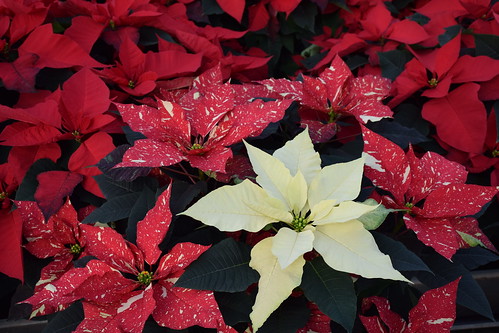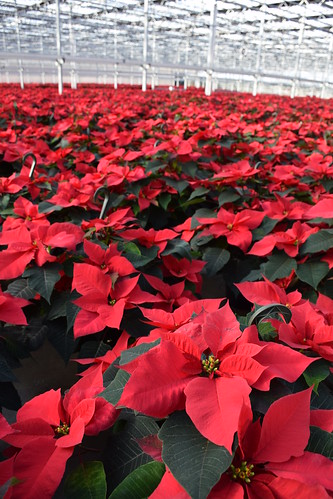
The poinsettia – academic types may call it by its binomial name, and biologists might refer to its species. But how many of us are guilty of calling it that red flower with the pointy leaves used to decorate during the holidays?
In the world of holiday shrubbery, the poinsettia has always taken a backseat to the Christmas tree. With its lights and ornaments, the tree has become the icon of the holiday in contrast to the poinsettia, which is usually placed in a nearby corner.
Perhaps it’s because we don’t fully understand it. For example, did you know the color portion is not the flower? They aren’t petals, they’re leaves called bracts. The flower portion is actually that tiny button-shaped piece in the middle of the top.
Have you ever spent quality time with a poinsettia? I mean, really looked at the rich, deep green of the bottom leaves, the unique shape and layering of the bracts – that vibrant and full-on beauty of its intense coloring. Its flower may be small, but it is darned regal-looking surrounded by the brilliant hues of its foliage.
The poinsettia, native to Mexico and Central America, was introduced into the United States in 1825 by Joel Roberts Poinsett, who was the first U.S. Minister to Mexico. Since then, the number of American poinsettia producers has grown. According to the Connecticut Greenhouse Grower’s Association’s Buyer’s Guide, the state has 17 poinsettia growers.
One of those is Grower Direct Farms of Somers, a family run wholesale greenhouse operation that produces annual and perennial ornamental plants. Owners Leonard and Elaine Van Wingerden are constantly striving to be on the forefront of leading edge technologies.
Several years ago, they noticed their electric bills climbing at an astronomical rate. One factor driving up those costs was the amount of heat required to grow poinsettias and other plants. The Van Wingerden’s knew they couldn’t continue status quo and stay in business, so they began looking for serious and effective ways to conserve and cut costs.
The Van Wingerden’s decided to take advantage of several USDA programs, including a conservation program offered by USDA’s Natural Resources Conservation Service, (NRCS). The Environmental Quality Incentives Program, or EQIP, helps farmers and ranchers conserve natural resources while improving their operation.

They worked with NRCS to complete an energy audit. And with financial assistance from NRCS, they installed a micro-irrigation system on four acres of land. A micro-irrigation system targets water to a plant’s root zone more efficiently and with less waste. They are also now in the process of installing insulation and solar curtains in the growing space to improve their operation’s energy efficiency.
With the help of NRCS and other USDA agencies, the Van Wingerden’s farm now grows acres of beautiful poinsettias in a more efficient way.
As for the holiday rivalry, the Christmas tree and poinsettia are beautiful and perfect examples of Mother Nature at her finest. But a poinsettia is a masterpiece with no need for extraneous adornment. It stands bright and shiny on its own.

